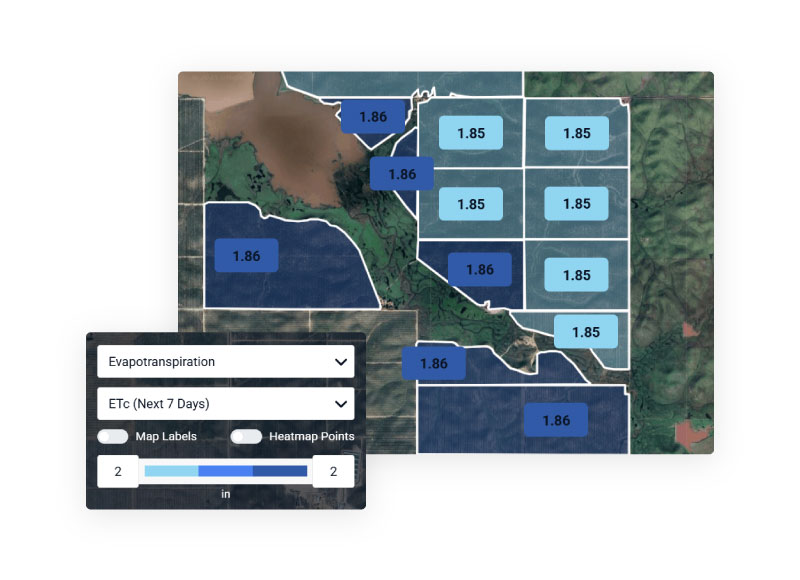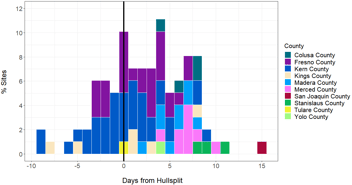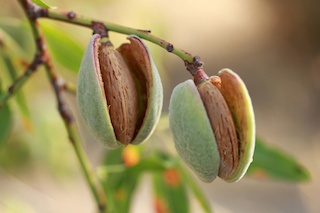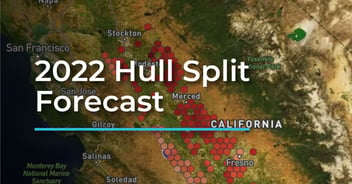Regulated Deficit Irrigation Around Almond Hull Split
In California, we're quickly approaching the point in the growing season when almond growers and their irrigation managers are planning regulated deficit irrigation strategies around hull split. Are you ready?
What is Regulated Deficit Irrigation (RDI)?
Regulated deficit irrigation is a strategy where irrigation is reduced to purposely induce stress on trees in order to achieve a specific goal.
In almonds, there are two common reasons to perform RDI. First, in years where less water is available, RDI can be used to reduce total water consumption without causing too much of a negative effect on yield if it’s carefully monitored. Second, and more common, this strategy is used to speed up hull split.
Why use Regulated Deficit Irrigation around hull split?
Hull split begins each year during late June or early July, when a deep “V” begins to form in the hull, exposing the shell and almond inside. This split can be dangerous, especially in soft-shell varieties as it makes the nut susceptible to diseases like hull rot or damage from navel orange worms.

Example of almond hull split, where the split exposes the soft shell inside
To limit the potential damage to the crop during this vulnerable period, growers can use a regulated deficit irrigation strategy. When deficit irrigations (irrigations that apply less water than the plant uses) are strategically planned around hull split, the nuts on the tree dry out quicker, making them a less ideal growing environment for the mold that causes hull rot. The shortened dry-out period also reduces the time when the nut is in the field and susceptible to damage from Navel Orange Worms.
How to plan for a Regulated Deficit Irrigation strategy
It is important to note that if done incorrectly, regulated deficit irrigation can quickly become unregulated and have a negative impact where it will delay hull split or result in a loss in kernel yield. Here are some tips and tools to help you form a deficit irrigation strategy.
General guidelines on the timing and duration of Regulated Deficit Irrigation
1. When a “V” begins to form on the hull right at the start of hull split, irrigations should decrease. It is important to note that during this time, if your soil moisture levels are already depleted, you should not induce any more stress than what is already present, as this will likely cause the hull split period to extend and a reduction in kernel weight will occur.
2. The period of deficit irrigation should last no longer than two weeks to prevent any long-term damage. Inducing too much stress for too long is detrimental to your crop. Another period of deficit will come as the crop is harvested. If hullsplit RDI goes too long, it will bleed into the harvest dry down and cause an extended period of water stress that can affect bloom next year. When two weeks of deficit irrigation are finished, resume heavier irrigations and refill the soil profile again just before harvest.
Make informed deficit irrigation decisions with Semios tools
1. Evapotranspiration (ET) monitoring: One way to accomplish RDI is to apply 50-70% of ETc. This reduces the soil moisture by applying less water than the tree uses. While many growers have relied on the nearest public or regional weather station for ET information, Semios’ in-canopy sensors provide the most accurate ET readings based on your unique in-canopy conditions and topography.

2. Soil moisture level monitoring: During regulated deficit irrigation, irrigation can be reduced until soil moisture levels deplete below 50%. Semios provides insights into the available water content in your soil using soil moisture probes so you can reliably assess how much water is available to your trees. After you’re finished with your regulated deficit irrigation, you can use the soil moisture status to ensure your trees are hydrated before harvest.

3. Plant stress monitoring: Knowing exactly how much stress your trees are under and for how long helps you prevent causing long-term damage. Semios uses dendrometers that provide a plant water stress measurement so you don't have to guess how much stress your trees are under. Raising stress levels until they reach moderate stress (yellow) provides enough stress to accelerate hull split without causing damage.

Performing RDI irrigations are not easy. Especially when trying to accomplish the right levels without very much data indicating when it is done properly. The right tools measuring the right features make hitting the sweet spot a little easier to do across more fields and year after year.
Want to learn more?
Have questions about your irrigation strategy and how Semios can help? Fill out the form below, and we will send more information your way:



